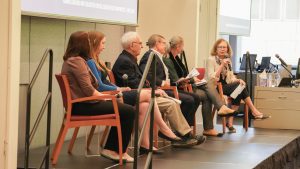As first appeared in the San Francisco Chronicle as On child care, Newsom and his budget could be bolder, on July 15, 2019. Reprinted with permission from the author.
As a candidate for governor, Gavin Newsom put forward a bold vision of high-quality early education for all the state’s youngest learners, and he is making good on his campaign promise. Early learning and child care occupy prominent places in the budget that went into effect this month, which is good news for a state that has fallen far behind most others in child care and early education quality and access.
The governor has said his goal is to make preschool available to every 3- and 4-year-old in California, and the new budget is a decent down payment on addressing the access problem. It will expand full-day public preschool for 4-year-olds in high-poverty communities and provide more money for facilities and training.
The budget also addresses quality indirectly by funding the development of a master plan for early education and child care by fall 2020. While taking time to work out the details is wise, some means of improving quality are obvious and important enough to be addressed without delay.
California needs to expand access to affordable child care and education, but we need to invest as much in quality as in access to get long-term benefits for children and the state. The research is clear that the quality of programs matters in reducing achievement gaps linked to family income. Universal preschool is a commendable goal, but expanding access without quality is not likely to improve results for kids in the long run.
Children’s experiences during the first five years of life lay the foundation for all future learning and development, and nothing affects the quality of those experiences more than teachers’ and caregivers’ preparation and support. And we know what we need to do to improve both.
First, we need to invest in higher salaries to stabilize the early-childhood education field. The people who care for the state’s youngest children are not paid a living wage, which is why 58% of child care providers receive public assistance such as Medicaid and food stamps. The average hourly wage of a California preschool teacher is $15.23, which is about half of what kindergarten teachers make, and benefits are rare. As a consequence, the state suffers from a shortage of early-childhood educators, turnover is high and many of the people who care for the state’s children suffer from added stress and anxiety.
These conditions conspire to undermine the quality of children’s educational experiences. It is difficult to be attentive, nurturing and effective in teaching and caring for children when you’re worried about meeting your own children’s basic needs.
California’s requirements for a preschool teaching permit, meanwhile, are among the lowest in the country, and no supervised practice teaching is required as it is for K-12 teachers. While most other states have implemented more rigorous preparation requirements for preschool teachers, California’s requirements haven’t changed since 1992.
Developing and implementing new requirements takes time, but that process could and should be launched now. Simultaneously, we must address salaries and benefits. Increased requirements without compensation to match would be unfair to people who are already paid far less than their similarly educated peers, and it would exacerbate the existing workforce shortage.
No further analysis is needed to determine that early education wages need a significant boost, so let’s at least make a down payment on that. The benefits of a more stable and less stressed teaching and caregiving workforce would be immediate, and then the state could get going on a long-overdue plan to improve teacher preparation.



